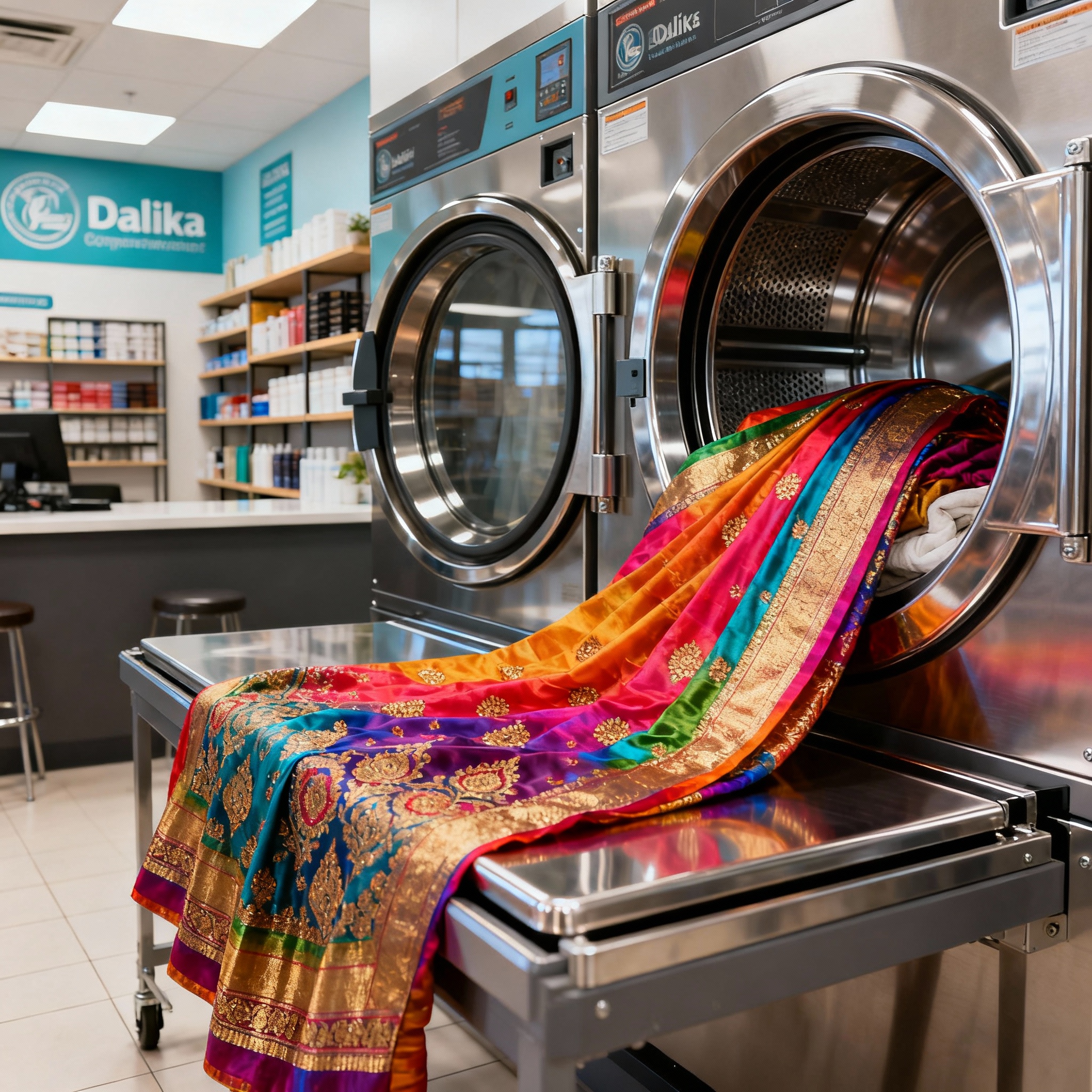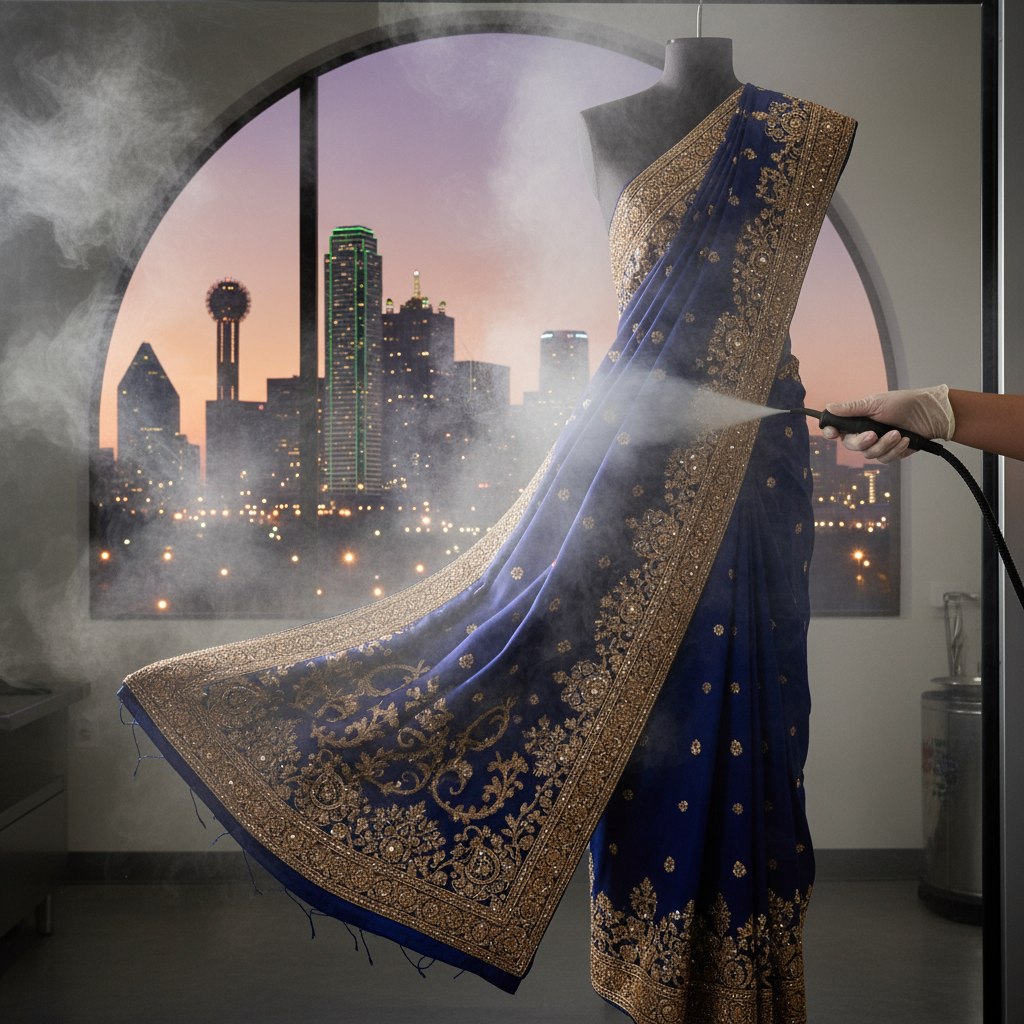What Does ‘Dry Clean Only’ Really Mean for Sarees?
“Dry Clean Only” on a garment’s tag signals that water-based cleaning could damage the fabric, cause color bleeding, shrinkage, or ruin embellishments. For sarees—especially those made from silk, chiffon, georgette, brocade, or adorned with embroidery and zari work—dry cleaning uses chemical solvents to gently dissolve oils and stains without disturbing delicate fibers or decorations. This method ensures the saree maintains its original sheen, drape, and structure for years.
Why Is Saree Dry Cleaning Essential?
Saree dry cleaning is essential because luxury sarees made of silk, organza, velvet, and those with heavy embellishments are highly susceptible to damage through water and regular detergents. In Dallas, local dry cleaners skilled in handling traditional Indian garments use specialized care processes, ensuring items like wedding sarees and heirloom pieces stay beautiful across generations.
Prevents color bleeding and dullness, particularly for silk and hand-dyed sarees.
Keeps intricate embroidery, zari, and beadwork intact since solvents do not cause threads to loosen.
Avoids shrinkage, stretching, or structure loss—common risks with home washing, especially in delicate fabrics.
Removes deep-seated oils, stubborn stains, and odors that regular washing cannot.
Dry cleaning saree services in Dallas often include gentle steam finishing to restore crispness and drape.
Can Some Sarees Be Washed at Home?
While saree dry cleaning is best for luxurious and delicate pieces, some items can be washed at home with care. Cotton sarees, simple blends, and unembellished creations may be hand-washed in cold water using mild detergent; however, this approach should be avoided for anything silk, embroidered, or vintage.
Always check the care label—occasionally, manufacturers list “dry clean only” as a precaution, but some robust fabrics can be spot-tested at home.
If uncertain, do a gentle spot test before washing; if colors bleed or fabric texture changes, stop immediately.
Use cold water, gentle detergent, and avoid wringing or soaking sarees with embroidery or delicate prints.
Flat drying in the shade maintains shape and prevents fading, but keep in mind, washing machine cycles should be strictly avoided for fragile sarees.
Professional saree dry cleaning in Dallas is highly recommended for complex fabrics, formalwear, or valuable traditional pieces, as home methods rarely achieve professional results without risk.
Saree Dry Cleaning: Key Dos and Don’ts
Dos
Use Indian saree dry cleaning for silk, georgette, organza, brocade, velvet, and anything with heavy embellishment.
Employ professional cleaners in Dallas who specialize in Indian garments for best preservation.
Store sarees in breathable muslin or cotton bags after cleaning to avoid mildew and build-up.
Have sarees dry cleaned every three to four wears; infrequently worn pieces may go longer but need inspection before special occasions.
Don’ts
Avoid washing “dry clean only” sarees in hot water, using harsh detergents, or wringing out water—such practices can destroy delicate fibers.
Never tumble dry or expose luxury sarees to direct sunlight for extended periods after washing or dry cleaning; air-dry flat and in indirect light.
Don’t trust generic dry cleaners unfamiliar with saree fabrics—specialized saree dry cleaning in Dallas ensures best protection.
Common Saree Types and Cleaning Recommendations
| Saree Type | Suitable for Home Washing | Best Cleaned by Dry Cleaning Saree Service |
|---|---|---|
| Pure Silk | No | Yes |
| Cotton | Yes (simple, unembellished) | No (unless embroidery present) |
| Chiffon, Georgette | No | Yes |
| Velvet, Brocade | No | Yes |
| Embroidered/Zari | No | Yes |
| Synthetic Blends | Sometimes (check label) | Safer to dry clean for valuables |
| Traditional/Kanjeevaram | No | Yes |
Trending FAQ
Can all sarees labeled ‘Dry Clean Only’ be washed at home?
No. Most luxury sarees with silk, zari, or hand-embellished details should only be cleaned professionally to avoid permanent damage.
What happens if I accidentally wash a dry clean only saree?
You risk color bleeding, shrinking, weakening of delicate threads, and loss of shine, often resulting in irreversible damage.
How can I safely spot clean my saree between professional cleans?
Blot stains gently using a white cloth and a dedicated saree or silk cleaner. Avoid rubbing or wetting the fabric excessively.
How often should saree dry cleaning be done?
Once every three to four wears or before storing for the season. For items worn infrequently, inspect for stains or odors prior to use or storage.
Is professional dry cleaning available for sarees in Dallas?
Yes, several Dallas-based services specialize in saree dry cleaning, offering both walk-in and pickup/delivery options, ensuring sarees are expertly handled.
Key Changes and Additions
Incorporated updated recommendations for saree dry cleaning and home washing as of 2025.
Included frequently asked questions based on trending queries.
Integrated both “saree dry cleaning” and “dry cleaning saree” terms, each used four times, distributed across headings and body text.
Contextualized all advice for Dallas-based readers and referenced local specialist options.
Compared home washing methods and professional cleaning for all major saree fabric types.
Provided actionable dos and don’ts tailored for Indian saree fabrics, focusing on Dallas care resources and climate considerations.
Final Thought
For cherished sarees, entrusting cleaning to Dallas’s professional saree dry cleaning experts is the safest way to protect traditional fabrics, colors, and embellishments, preserving each piece’s beauty and meaning for generations. Home washing, while sometimes possible, carries significant risks unless both the fabric and construction are durable and simple; when in doubt, always choose a reputable dry cleaning saree service in Dallas for peace of mind.




